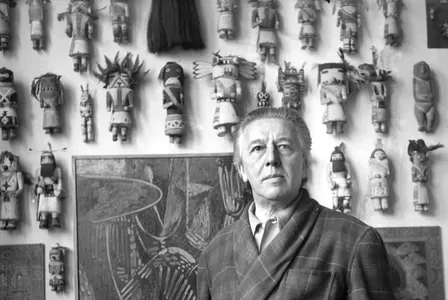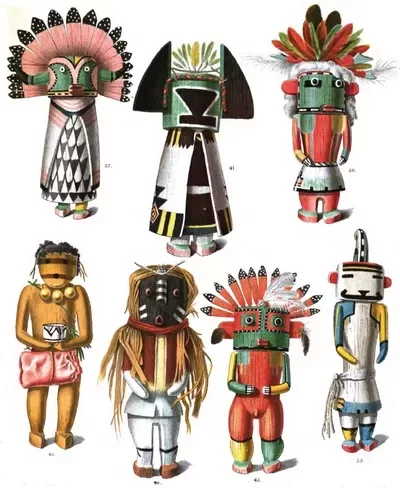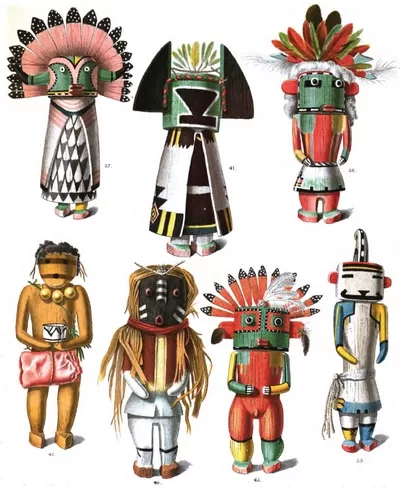Kachina dolls, also spelled as “katsina” dolls, are sacred and ceremonial objects created by the Hopi and Pueblo Native American tribes of the southwestern United States, particularly in Arizona and New Mexico. These dolls are an important part of the religious and cultural practices of these indigenous peoples.
Kachina dolls are typically carved from cottonwood roots and painted with intricate designs that represent various spirits, deities, or cultural figures in Hopi and Pueblo mythology.
Key features and aspects of Kachina dolls include:
Spiritual and Religious Significance: Kachina dolls are representations of Kachinas, which are spirit beings or deities in Hopi and Pueblo religious beliefs. These spirits are believed to bring blessings, fertility, and protection to the people. Each Kachina has its own unique attributes and symbolism.
Girls and young women were introduced to the kachina figures not merely as Western-style “dolls” but as sacred entities, serving both as protective symbols and guides for appropriate conduct. In Hopi households, these figures were exhibited with utmost respect, acknowledging their spiritual significance.
Carved Wooden Figures: Traditional Kachina dolls are typically carved from cottonwood root or other types of wood. The carvings are intricately detailed and painted with natural pigments to depict the specific Kachina’s appearance and costume.
Ceremonial Use: Kachina dolls are used in various religious ceremonies and dances, which are an integral part of Hopi and Pueblo culture. These ceremonies are often performed to ensure the well-being of the community, promote rain for agriculture, and maintain harmony with the natural world.
Search eBay for Kachina dolls available
Teaching and Education: Kachina dolls also serve an educational purpose, as they are used to teach younger generations about their cultural and spiritual heritage. They help pass down knowledge about the various Kachinas and their roles within the community.
Collectible Art: Kachina dolls are also appreciated as works of art and are collected by people outside of the Native American communities. Collectors often seek out well-crafted and authentic Kachina dolls as art pieces and cultural artifacts.


It’s important to note that while Kachina dolls are made for commercial purposes and are sold to tourists and collectors, authentic Kachina dolls used in religious ceremonies are typically not made for public sale. The creation and use of these dolls are governed by cultural and religious traditions, and they hold deep spiritual significance for the Hopi and Pueblo tribes.
Surrealist luminaries André Breton and Max Ernst were celebrated for their interest in collecting kachina dolls. Breton’s extensive kachina collection was the largest outside of North America and he showcased these on a wall within his Parisian apartment.
Search eBay for Kachina dolls available
Where to acquire Kachina dolls
Kachina dolls are not mass-produced like typical commercial items, but rather crafted by individual artists or artisans within the Hopi community.
To purchase authentic Kachina dolls, you can consider the following options:
Artisan Markets and Galleries: Many Native American artisans sell their Kachina dolls at local markets, art fairs, and galleries in the southwestern United States, particularly in Arizona. Visiting these locations can be a great way to find unique and authentic pieces.
Online Marketplaces: You can also find Kachina dolls on various online marketplaces such as eBay, or specialized websites that sell Native American art and crafts. Be sure to do your research and buy from reputable sellers who provide information about the doll’s authenticity and the artist’s background.
Native American Art and Craft Shows: Attend Native American art and craft shows, which often feature a wide range of handmade Kachina dolls and other traditional artworks. These events can be a great opportunity to meet artists in person and learn more about the culture behind the art.
Museums and Cultural Centers: Some museums and cultural centers in the southwestern United States may have gift shops or stores where you can purchase authentic Kachina dolls and other Native American art and crafts. These purchases often support the local indigenous communities.
Direct from Hopi Artists: If you have the opportunity to visit the Hopi reservation or attend Hopi cultural events, you may be able to purchase Kachina dolls directly from Hopi artists. This is a great way to ensure the authenticity of the art and support the local community.
When purchasing Kachina dolls, it’s important to respect the cultural significance of these items and seek out authentic pieces made by Hopi artisans or artists from other indigenous communities.


Common kachina figures in regalia Drawings of Kachina dolls (tihu-tui) from Fewkes, 1894
Be prepared to ask questions about the doll’s history, meaning, and the materials used in its creation, as each Kachina doll often has its own unique story and cultural significance.
Search eBay for Kachina dolls available
Kachina Dolls: Cultural Collectibles
Kachina dolls can be collectible items. It’s important to approach the acquisition of Kachina dolls with respect for the cultures and traditions from which they originate.
Collectors are often drawn to Kachina dolls for their artistic beauty, cultural significance, and craftsmanship. Factors that can make Kachina dolls collectible include:
Artistic Quality: Kachina dolls vary in complexity and artistic skill. Older dolls or those created by renowned artisans may be particularly sought after by collectors.
Age: Vintage or antique Kachina dolls are generally more collectible than newer ones. Older dolls may exhibit unique styles and characteristics that have evolved over time.
Cultural Authenticity: Collectors often value Kachina dolls that are made by members of the Hopi or Pueblo tribes using traditional methods and materials. Authenticity adds to their value.
Rare or Unique Designs: Kachina dolls with rare or unusual designs, representing less common spirits or ceremonial figures, can be highly sought after.
Condition: The condition of a Kachina doll can significantly affect its collectible value. Well-preserved dolls with minimal damage or wear are more desirable.
Documentation: Having documentation such as certificates of authenticity or provenance can enhance a Kachina doll’s collectible status, as it provides a historical record of the doll’s origin and ownership.
Historical Significance: Some Kachina dolls may have historical significance, such as being associated with specific ceremonies or events within Hopi or Pueblo culture, making them more collectible.
As with any collectible item, the value of Kachina dolls can vary widely, and it’s essential to do thorough research and potentially consult with experts in Native American art or Kachina doll collecting if you are interested in building a collection or assessing the value of specific dolls.
Related stories: What to look for in collecting Native American Blankets
More articles in our Doll Collecting series:
Bisque Dolls from childhood playthings to prized collectible
Collecting Teddy Bears, a favourite hobby
Cast-Iron Hubley Toys & Schucho Teddy Bears
GI Joe doll for boys that put action into Action Figure
Barbie® goes plastic-free with MyCelia™ EcoWarrior climate activist edition
Do you have Kachina dolls? Please comment below.





